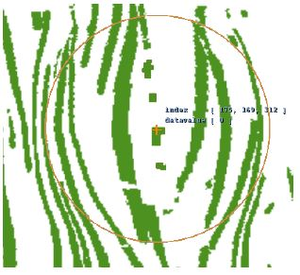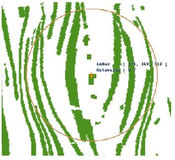Information
- Publication Type: Bachelor Thesis
- Workgroup(s)/Project(s):
- Date: August 2017
- Date (Start): February 2017
- Date (End): 23. August 2017
- Matrikelnummer: 01326465
- First Supervisor: Eduard Gröller
Abstract
The exploration of data visualisations has become an important task and already reaches beyond scientific purposes. Especially, in material sciences and related industries, data analysis is crucial for the detection of possible error sources or weak spots, that occurred during fabrication, to meet the required quality criteria. open_iA is an open source software that offers such data analysis of computed tomography material data. This thesis addresses the topic of data exploration by implementing and integrating a 2D fish-eye lens into open_iA. The fish-eye lens has been chosen due to its magnification characteristics, that provide focus and context at the same time. The distinct distortion of the fish-eye lens was achieved by applying a thin-plate spline (TPS2) transformation to the dataset. Beside the fish-eye lens, there exist many more magic lenses for different kinds of datasets and purposes, which will be introduced in a few words. Furthermore, the hard- and software requirements for the fish-eye lens as well as general design concepts are defined. Then, a detailed explanation of the thin-plate spline transformation and its algorithm is given and illustrated with example datasets and step-by-step calculations. Finally, the fish-eye lens is tested for its functionality and usability with material datasets.Additional Files and Images
Weblinks
No further information available.BibTeX
@bachelorsthesis{brandstaetter_01,
title = "Implementation and Evaluation of a Fish-Eye Lens for
Interactive Visualization of Features in Volumetric Datasets",
author = "Klara Brandst\"{a}tter",
year = "2017",
abstract = "The exploration of data visualisations has become an
important task and already reaches beyond scientific
purposes. Especially, in material sciences and related
industries, data analysis is crucial for the detection of
possible error sources or weak spots, that occurred during
fabrication, to meet the required quality criteria. open_iA
is an open source software that offers such data analysis of
computed tomography material data. This thesis addresses the
topic of data exploration by implementing and integrating a
2D fish-eye lens into open_iA. The fish-eye lens has been
chosen due to its magnification characteristics, that
provide focus and context at the same time. The distinct
distortion of the fish-eye lens was achieved by applying a
thin-plate spline (TPS2) transformation to the dataset.
Beside the fish-eye lens, there exist many more magic lenses
for different kinds of datasets and purposes, which will be
introduced in a few words. Furthermore, the hard- and
software requirements for the fish-eye lens as well as
general design concepts are defined. Then, a detailed
explanation of the thin-plate spline transformation and its
algorithm is given and illustrated with example datasets and
step-by-step calculations. Finally, the fish-eye lens is
tested for its functionality and usability with material
datasets. ",
month = aug,
address = "Favoritenstrasse 9-11/E193-02, A-1040 Vienna, Austria",
school = "Institute of Computer Graphics and Algorithms, Vienna
University of Technology ",
URL = "https://www.cg.tuwien.ac.at/research/publications/2017/brandstaetter_01/",
}

 image
image

